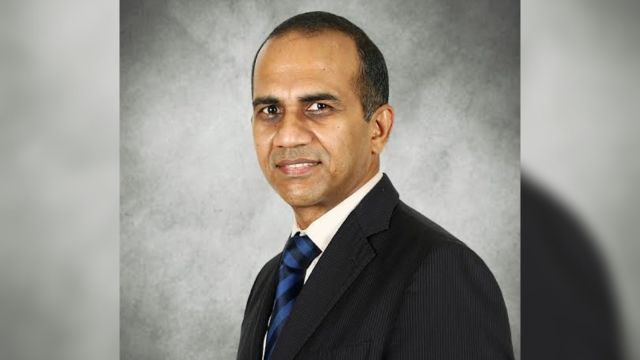‘Training of AI in Indian context, languages will drive regional expansion of data centres’
Venkatraman Swaminathan discusses the reliability of power supply for data centres, the potential of renewable energy storage, and how the rise of AI is driving the expansion of data centre infrastructure.
 Venkatraman Swaminathan, Vice President & Country General Manager, India & SAARC, Secure Power Division at Schneider Electric. (Express Photo)
Venkatraman Swaminathan, Vice President & Country General Manager, India & SAARC, Secure Power Division at Schneider Electric. (Express Photo)Schneider Electric, a global leader in energy management and automation, is also a key player in the data centre sector. It has collaborated with NVIDIA on AI data centre reference designs and operates a 6.5-acre facility in Bangalore producing advanced cooling systems, most of which are exported. In a conversation with Aggam Walia, Venkatraman Swaminathan, Vice President & Country General Manager, India & SAARC, Secure Power Division at Schneider Electric, discusses the reliability of power supply for data centres, the potential of renewable energy storage, and how the rise of AI is driving the expansion of data centre infrastructure.
Data centres need a reliable power supply for uninterrupted operations. How has this evolved in India, especially with more end users demanding renewable energy?
In general, data centres require power as raw material. Land parcels in non-seismic areas become the second consideration, and the third is safety and security. Mumbai has become the hotspot with almost 50 per cent of India’s data centres because of the perceived stability and long-term reliability of power. So in terms of power, all states are now looking at Mumbai’s success.
Chennai has a unique advantage because of its cable landing stations, which connect it to Singapore through undersea cables, enhancing connectivity and reducing latency. Chennai and Hyderabad are also attracting interest because of their power surplus. States are positioning themselves by ensuring stable power supply, which is a major factor for data centre development.
Meanwhile, Delhi and Kolkata are seeing less movement due to concerns around seismic activity and power availability. That said, if you ask whether India has sufficient power for data centres, the answer is yes. Companies are also looking to reduce power costs by integrating solar energy. Companies like AWS and Microsoft must also report their carbon emissions, so they’re moving towards green energy.
What role do you see battery storage playing in the near future, and what about other options, like nuclear, to ensure round-the-clock green energy supply?
Beyond stable power sources, alternative energy solutions for data centres are still in various stages of infancy. Some firms are experimenting with fuel cells — for instance, a data centre in Bengaluru has implemented a proof-of-concept installation.
Everybody is talking about battery storage but there’s nothing comprehensive yet, they’re still with diesel generators (DGs). While there are calls to phase out DGs due to carbon footprint concerns, data centres in places like Mumbai, which have had no major power disruptions for years, mostly use them as insurance.
Large business houses are moving into importing battery cell technologies to build batteries and store solar energy because solar input at nights and in winters is lower. Still, I haven’t seen large-scale battery storage replacing DGs in India.
Nuclear power takes a long time to develop, and with hydro, we don’t have too many hydroelectric plants close to the cities. Hydrogen-based power generation, used overseas in some cases, could emerge as an option. For now, data centres will likely continue using a mix of DGs and mains power for at least another year and a half till battery energy storage becomes more mature.
How do you see data centre deployment expanding beyond tier-1 cities in India? Additionally, how will the balance between hyperscale and edge facilities evolve in the coming years?
The bandwidth requirements for cloud data centres has been manageable in cities like Chennai, Mumbai, Bangalore, and Hyderabad. While users may tolerate occasional buffering on their phones, AI applications require seamless performance. For instance, Singapore’s autonomous vehicle projects generate terabytes of data every minute, accelerating the need for edge data centres.
AI data centres will require regional and edge data centres, especially for applications in agriculture, where AI can assist farmers with soil analysis and improving crop yields. This will drive the regionalisation of data centre capacity beyond urban areas.
The trend is moving towards a combination of hyperscale, regional, and edge data centres, depending on the end use application. Currently, there is not much training happening in India, it’s mostly AI inference. Since we have over 20 official languages and so many dialects, I believe you have to train AI in the Indian context, therefore you will see more regional and edge data centres, which is inevitable.
How could India emerge as a key player in the broader region?
AI will be used more for operational efficiency and saving time. With end users increasing, I see more implementation, and India has always leapfrogged in absorbing technology. I believe India is going to be a hotspot for AI data centres.
Also, because the cost per megawatt of deployment in India is more frugal, at least 30 per cent lower, and since data centres are capex intensive, India is going to be a key destination. India stands to gain in south and southeast Asia by being neutral and attracting more foreign direct investments.
Must Read
Buzzing Now



Apr 12: Latest News
- 01
- 02
- 03
- 04
- 05























